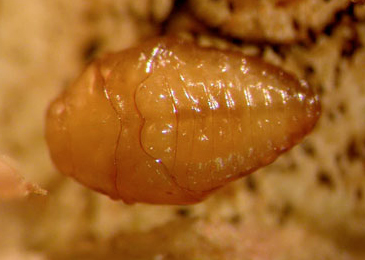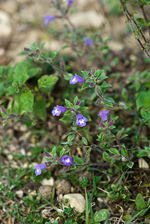|
||||||
|
CLINOPODIUM. Basil Thyme, Calamints and Wild Basil. [Lamiaceae] |
|
|
Seven species of Clinopodium are recorded in Britain. These include the native Basil Thyme (C. acinos), Common Calamint (C. ascendens), Lesser Calamint (C. calamintha), Wood Calamint (C. menthifolium) and Wild Basil (C. vulgare). Wood Calamint (C. menthifolium) is protected under Schedule 8 of the Wildlife and Countryside Act, 1981. Eight British miners are recorded on Clinopodium. A key to the European miners recorded on Clinopodium (including Acinos, Calamintha, Satureja, Calamint, Savory) is provided in Bladmineerders van Europa. |
|
|
Key for the identification of the known mines of British |
1a >Stem-miner: A narrow, inconspicuous stem mine. Pupation at the end of the mine (Spencer, 1976: 64). Fine, upper- or lower-surface corridor, ending in a thick vein. From there the mine extends finally to the rind of the stem. There also the pupation takes place, usually not far from the root collar. Mines in the stem rind often are conspicuous through a red discoloration. |
|
Ophiomyia curvipalpis (Zetterstedt, 1848) [Diptera: Agromyzidae]. |
1a > Stem miner: A shallow, inconspicuous external stem mine. Pupation in stem near a node (Spencer, 1972b: 29). |
|
Ophiomyia labiatarum Hering, 1937 [Diptera: Agromyzidae]. |
1c > Leaf-miner |
2a > Leaf-miner and case-bearer: The larva lives outside the mine, protected by a case, and feeds on the underlying plant tissues via a hole cut in the epidermis. From that point it eats away as much leaf tissue as it can reach without fully entering the mine. Mine does not contain frass (Coleophora species) |
2b > Leaf-miner, but not a case-bearer: The larva lives mainly inside the mine. Mine usually contains frass. In later instars the larva may live sandwiched between two more or less circular sections cut from the leaf. |
3 > Leaf-miner and case-bearer: Blotch mines reaching the edge of the leaf, initially pale green turning brownish white, are caused by the larva feeding on the underside of a leaf. The fully developed case is slender, shining black brown, about 9 mm long. Towards the end a narrow, transparent yellowish ventral keel. Mouth angle 50-60°. Cases on the leaf underside. |
|
Coleophora albitarsella Zeller, 1849 [Lepidoptera: Coleophoridae]. |
4a > Leaf-miner: Rather long corridor winding through the leaf, regularly crossing itself. The corridor later widens considerably. Frass normally in a narrow central line, but may also lie along the side, or be absent. The larva regularly leaves a mine and restarts elsewhere. |
|
Apteropeda globosa (Illiger, 1794) [Coleoptera: Chrysomelidae]. |
4b > Leaf-miner: Rather long full depth corridor that winds freely through the leaf and may cross itself. In the end the corridor widens considerably. Frass mostly in a narrow central line, but may also be deposited along the sides or be missing. The larvae regular leave a mine to restart elsewhere. Pupation outside the mine. Neither larva or mine can be distinguished from that of related species. |
|
Apteropeda orbiculata (Marsham, 1802) [Coleoptera: Chrysomelidae]. |
4c > Leaf-miner: Egg at the underside of the leaf, in the basal part, near the midrib. The mine begins as a long, narrow, full depth gallery running towards the leaf tip; frass here in a narrow central line. After the leaf tip has been reached a large, full depth, brown blotch is made. Much silk is deposited within, strongly contracting the mine and making it opaque. Frass lies in big black lumps here either in the oldest part, or in the centre, of the blotch. The larvae are capable of leaving their mine and restarting elsewhere, in which case the initial corridor is missing. Larvae of the first generation hibernate in the mine. Pupation external, in a white spinning, often between the leaves of the hostplant. |
|
Stephensia brunnichella (Linnaeus, 1767) [Lepidoptera: Elachistidae]. |
4d > Leaf-miner: Upper-surface, transparent blotch that begins at the leaf margin, generally at the underside of the leaf. Oviposition site covered by a shining brown drop of hardened secretion. Frass in grains or thread fragments. |
 Trachys scrobiculatus pupa, dorsal Image: © Jean-Yves Baugnée (Bladmineerders van Europa) |
|
? Trachys scrobiculatus Kiesenwetter, 1857 [Coleoptera: Buprestidae]. |
4e > Leaf miner: Mine beginning with a small spiral, later developing into a greenish blotch, brown when old. Pupation frequently in mine (Spencer, 1972b: 90). The mine, that may be upper- or lower-surface, generally starts with a tight spiral. Its loops are so tight that the leaf tissue dies off and turns red; nevertheless the corridor remains well visible. Later the corridor widens and finally a large secondary blotch develops around the initial spiral. Frass at first in two rows of grains, later in pearl chains. Feeding lines very clear. Pupation now within, then outside the mine. |
|
Phytomyza obscura Hendel, 1920 [Diptera: Agromyzidae]. |
| Last updated 02-Jul-2019 Brian Pitkin | ||

